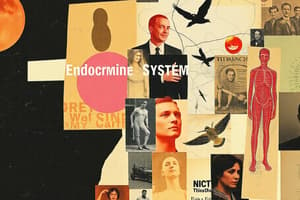Podcast
Questions and Answers
What is the function of the endocrine and nervous systems?
What is the function of the endocrine and nervous systems?
They work together to monitor and adjust physiological activities in the body at any given moment.
What does the endocrine system consist of?
What does the endocrine system consist of?
Pituitary gland, thyroid gland, parathyroid glands, thymus, adrenal glands.
What is the definitive function of the endocrine system?
What is the definitive function of the endocrine system?
Produces hormones.
What produces steroid-cholesterol-based molecules?
What produces steroid-cholesterol-based molecules?
What is an amino acid derivative?
What is an amino acid derivative?
What is an example of an amino acid derivative?
What is an example of an amino acid derivative?
What are peptides?
What are peptides?
What exerts nervous control on the adrenal medulla?
What exerts nervous control on the adrenal medulla?
What is the role of the hypothalamus in the endocrine system?
What is the role of the hypothalamus in the endocrine system?
What causes diabetes insipidus?
What causes diabetes insipidus?
What is negative feedback?
What is negative feedback?
What is positive feedback?
What is positive feedback?
What is an example of positive feedback?
What is an example of positive feedback?
What is another name for posterior pituitary?
What is another name for posterior pituitary?
What do the supraoptic nucleus of the posterior pituitary contain?
What do the supraoptic nucleus of the posterior pituitary contain?
What is ADH?
What is ADH?
What are the functions of ADH?
What are the functions of ADH?
What triggers the release of ADH?
What triggers the release of ADH?
What does the paraventricular nucleus of the posterior pituitary produce?
What does the paraventricular nucleus of the posterior pituitary produce?
What are the functions of oxytocin?
What are the functions of oxytocin?
What is another name for anterior pituitary?
What is another name for anterior pituitary?
What are the parts of the anterior pituitary?
What are the parts of the anterior pituitary?
What is the hypophyseal portal system?
What is the hypophyseal portal system?
What are the hormones of the anterior pituitary?
What are the hormones of the anterior pituitary?
Where is MSH released from?
Where is MSH released from?
What does ACTH do?
What does ACTH do?
What do GH and somatostatin target?
What do GH and somatostatin target?
What are the functions of GH?
What are the functions of GH?
What does TSH target?
What does TSH target?
What does PRL target?
What does PRL target?
What does FSH target and promote?
What does FSH target and promote?
What is the function of LH?
What is the function of LH?
What is the function of ICSH?
What is the function of ICSH?
What is the thyroid?
What is the thyroid?
What do the two lobes of the thyroid contain?
What do the two lobes of the thyroid contain?
What do TX, T4, and T3 do?
What do TX, T4, and T3 do?
What do C cells of the thyroid produce?
What do C cells of the thyroid produce?
What does calcitonin do?
What does calcitonin do?
Where does the thyroid store its hormones?
Where does the thyroid store its hormones?
What are the parathyroid glands?
What are the parathyroid glands?
What do the principal (chief) cells of the parathyroid gland produce?
What do the principal (chief) cells of the parathyroid gland produce?
What does PTH do?
What does PTH do?
What does decreased PTH result in?
What does decreased PTH result in?
What are the characteristics of the thymus?
What are the characteristics of the thymus?
What does thymosin do?
What does thymosin do?
What does the adrenal cortex produce?
What does the adrenal cortex produce?
What are the functions of zona glomerulosa?
What are the functions of zona glomerulosa?
What does zona fasciculata produce?
What does zona fasciculata produce?
What are the characteristics of zona fasciculata?
What are the characteristics of zona fasciculata?
What would damage to zona fasciculata result in?
What would damage to zona fasciculata result in?
What does zona reticularis produce?
What does zona reticularis produce?
What is an important role of TX, T4, T3?
What is an important role of TX, T4, T3?
What is unique about GH?
What is unique about GH?
What is a gonadocorticoid?
What is a gonadocorticoid?
Flashcards are hidden until you start studying
Study Notes
Endocrine System Overview
- The endocrine system and nervous system collaborate to regulate physiological activities continuously.
- Key components include the pituitary gland, thyroid gland, parathyroid glands, thymus, and adrenal glands.
Hormones and Functions
- The primary function is hormone production, which impacts various bodily functions.
- Steroid hormones produced by the adrenal cortex and sex organs are cholesterol-based.
- Amino acid derivatives, like thyroid hormones, act through second messengers.
- Peptides, composed of groups of amino acids, also play significant roles in hormone function.
Hypothalamus Role
- Acts as the "manager" of the endocrine system, controlling endocrine cells.
- Signals the anterior pituitary to release or inhibit hormones through releasing hormones (RH) and inhibiting hormones (IH).
- Produces antidiuretic hormone (ADH) and oxytocin.
Feedback Mechanisms
- Negative feedback is common, stabilizes physiological processes, and maintains homeostasis.
- Positive feedback is rare but used in processes like oxytocin release during childbirth.
Pituitary Gland
- Anterior pituitary is also known as adenohypophysis; posterior pituitary is called neurohypophysis.
- Anterior pituitary releases several hormones through the hypophyseal portal system to minimize dilution.
- Major anterior pituitary hormones include:
- Melanocyte-Stimulating Hormone (MSH)
- Adrenocorticotropic Hormone (ACTH)
- Growth Hormone (GH)
- Prolactin (PRL)
- Thyroid Stimulating Hormone (TSH)
- Follicle-Stimulating Hormone (FSH)
- Luteinizing Hormone (LH)
Thyroid Gland
- A butterfly-shaped gland below the larynx, responsible for iodine incorporation into hormones.
- Produces thyroxine (T4) and triiodothyronine (T3) which accelerate metabolism and energy usage.
- C cells in the thyroid produce calcitonin, reducing blood calcium levels.
Parathyroid Glands
- Four tiny glands located on the back of the thyroid.
- Principal cells produce parathormone (PTH) which increases blood calcium levels, opposing calcitonin's effects.
- Decreased PTH can cause muscle spasms.
Thymus
- Located in the mediastinum, most active during infancy and childhood.
- Produces thymosin which promotes lymphocyte development.
Adrenal Glands
- Adrenal Cortex
- Divided into three zones:
- Zona Glomerulosa produces mineralcorticoids like aldosterone, affecting mineral balance and fluid retention.
- Zona Fasciculata produces glucocorticoids such as cortisone and cortisol, essential for stress resistance and anti-inflammatory responses.
- Zona Reticularis produces gonadocorticoids, contributing to testosterone production.
- Divided into three zones:
Hormonal Effects
- Thyroid hormones (T4 and T3) are crucial for physical, intellectual, and sexual maturation.
- GH uniquely targets all cells, promoting growth and mobilizing fats and glucose.
- Functions of ADH include urine concentration and water conservation, triggered by electrolyte rise or blood pressure drop.
- Oxytocin induces uterine contractions and milk ejection, influencing reproduction and lactation.
Summary of Key Hormones
- FSH targets ovarian follicles and testicular cells, promoting gametogenesis.
- LH stimulates the corpus luteum for progesterone production.
- ICSH (Interstitial Cell Stimulating Hormone) stimulates testes interstitial cells for testosterone production.
Studying That Suits You
Use AI to generate personalized quizzes and flashcards to suit your learning preferences.




